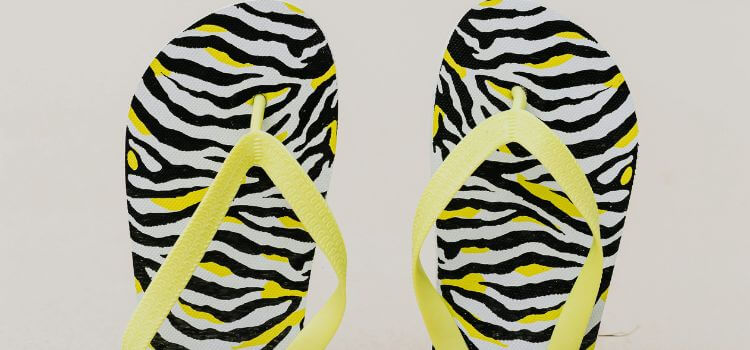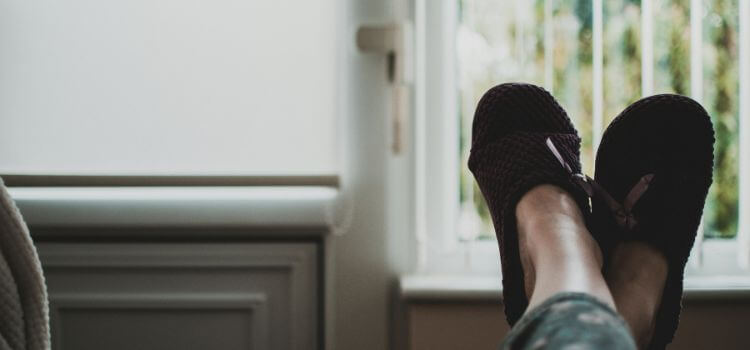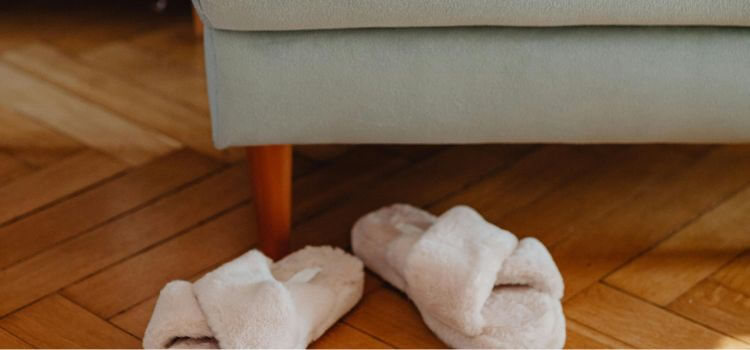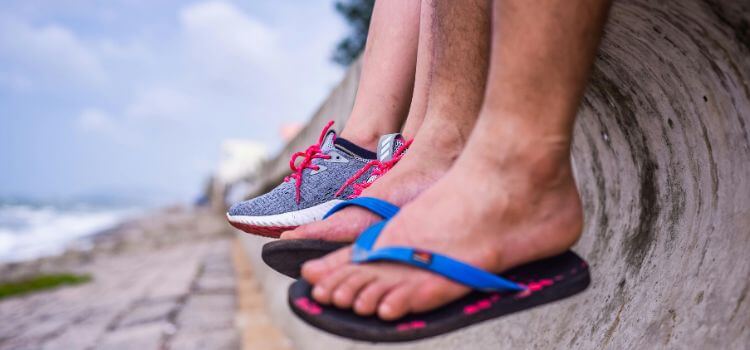On average, slippers last between 6 to 12 months. Durability depends on material quality and frequency of use.
Slippers are a household essential, offering comfort and convenience for indoor wear. Often, the first thing we reach for after a long day is a good pair of slippers, which can feel like a sanctuary for our feet. However, their lifespan is not indefinite.

Factors such as the construction material, the level of support provided, and the environment in which they are all play a crucial role in determining their durability. For instance, regular use on rough surfaces can significantly shorten their life. Therefore, choosing fitting slippers with robust materials and proper care is vital to ensuring they last as long as possible while providing comfort and ease for your daily indoor adventures.
Slipper Lifespan Basics
Imagine snuggling your feet into a cozy pair of slippers after a long day. Comfort is critical, but so is knowing how long that soft embrace will last. Slippers’ lifespan is a tale of materials, care, and use. Let’s explore the factors that keep your tootsies toasty for longer.
Typical Durability Factors
Several elements determine how long slippers withstand daily wear and tear. Material quality tops the list. High-grade leather or textiles can enhance longevity. The design also plays a crucial role; reinforced seams and robust soles resist breakdown.
User habits impact slipper survival. Wearing them outside or in rough conditions can shorten their life. Care is critical—slippers need regular cleaning and proper storage to extend their use. Here’s a quick rundown of these durability factors:
- Material Quality: Higher quality means longer life.
- Design Strength: Sturdier construction means more wear.
- User Habits: Gentle use equals a longer lifespan.
- Care Routines: Clean and store well for longevity.
Average Lifespan Estimates
So, how long should you expect your comfy companions to last? On average, a well-made pair of slippers can last 6 months to over 2 years. It depends on how often and where you wear them. Here’s a simple breakdown:
| Usage | Lifespan |
| Daily Indoor Use | 1-2 years |
| Occasional Use | Up to 3 years |
| Outdoor Use | 6-12 months |
To maximize lifespan, match slipper use to their design. Outdoor slippers are for the outdoors, while indoor ones prefer the inside. Keep them in their favorite environment, and they’ll keep your feet happy for longer.
Materials Matter
When choosing slippers, consider the materials. They are essential to how long your slippers last. Better materials mean longer-lasting comfort. Let’s examine the common materials used and their impact on slipper durability.

Common Slipper Materials
Slippers come in a range of materials. Each offers different levels of comfort and wear. We often see:
- Cotton: Soft and breathable, ideal for summer.
- Wool: Warm and cozy, perfect for cold weather.
- Suede: Stylish and durable, with a classic look.
- Leather: Tough and long-lasting, they age well.
- Synthetics: Affordable and easy to clean.
Material Impact On Durability
The materials used in slippers directly affect their lifespan. Here’s how:
| Material | Durability |
| Cotton | It is less durable and wears quickly. |
| Wool | Durable, but can stretch out. |
| Suede | Resilient, but needs care. |
| Leather | It is very durable and better with age. |
| Synthetics | Varies, often less breathable. |
Choose wisely. Quality materials can make slippers last years, not months. Think about your needs and pick materials that match. You’ll enjoy comfort and durability hand in hand.
Usage Patterns
Understanding how usage patterns affect slipper longevity is essential. Slippers are not just cozy comfort for your feet; they are everyday items. But how long do they last? This depends mainly on how often and where you wear them.
Daily Wear And Tear
Slippers endure a lot every day. Each step contributes to their wear and tear. The material of the slippers matters a lot. Wool, cotton, and fleece are standard materials. They offer comfort but can wear out faster with daily use. Quality also plays a role. Higher quality slippers may cost more but tend to last longer.
- Frequent use leads to quicker degradation.
- The surface type affects the soles. Hard floors can be harsh on them.
- Outdoor use can shorten the slipper’s lifespan. Stick to indoor use if possible.
Effects Of Overuse
Overusing slippers can lead to a quicker breakdown. The padding flattens, and the soles wear down. This can make them uncomfortable and less supportive over time. Here’s how overuse can impact your slippers:
| Component | Effect of Overuse |
| Soles | Wear thin and may split |
| Insole | Lose cushioning, affecting comfort |
| Fabric | Stretches and loses shape |
Remember, moderate use and proper care are vital to extending the life of your slippers. Give them a break from time to time, which helps them retain their shape and comfort for longer.
Care And Maintenance
Proper care is essential for ensuring your slippers last a long time. Regular cleaning and correct storage are vital. By following simple maintenance steps, you can significantly extend the lifespan of your slippers.
Cleaning Techniques
Regular cleaning keeps your slippers in top shape. Here are effective ways to clean them:
- Hand wash soft fabric slippers with mild detergent and warm water.
- Use a soft brush for stricter materials like suede.
- Machine wash only if the label says it’s safe.
- Air dry slippers to prevent shrinkage and fabric damage.
Spot clean stains immediately to avoid permanent marks.

Storage Tips
Proper storage is crucial for keeping your slippers usable for years. Follow these tips:
- Store in a cool, dry place away from direct sunlight.
- Avoid piling up slippers. Keep them side by side.
- Use shoe trees or soft stuffing to maintain shape.
Remember, good storage prevents deformation and material decay.
Signs Of Wear
Slippers keep our feet cozy, but they don’t last forever. Signs of wear tell us when it’s time to say goodbye. Let’s explore these signs.
Recognizing Time For Replacement
Slippers work hard daily. They protect your feet from cold floors. Over time, they show signs of aging. Look for these indicators that your slippers need replacing:
- Frayed edges or holes in the fabric
- Thinning soles that no longer provide cushion
- Flattened insoles that don’t support your feet
- Stretched out shape, losing grip on your feet
- A foul odor that doesn’t go away even after cleaning
Safety Concerns With Worn Slippers
Worn slippers are not just uncomfortable. They can be unsafe. Here’s how:
| Wear Sign | Safety Risk |
| Smooth soles | Increased risk of slipping |
| Holes insoles | Possible cuts from sharp objects |
| Loose inner lining | Trip hazard |
| Exposed seams | Skin irritation |
Keep your feet safe. Inspect your slippers regularly for these signs. Replace them when needed to maintain comfort and safety.
Economic And Environmental Impact
The economic and environmental impact of slippers extends beyond their cozy comfort. The longevity of slippers matters. It affects both our wallets and the planet. Let’s explore how investing in quality slippers can be cost-effective and environmentally friendly.
Cost-effectiveness Of Quality Slippers
When we buy slippers, we often go cheap and replace them frequently or invest more for durability. Quality slippers might seem pricey, yet they offer long-term savings.
- Durable materials resist wear and tear.
- Long-lasting slippers mean fewer replacements.
- Less frequent shopping trips save time and money.

Consider this comparison:
| Slipper Type | Initial Cost | Life Expectancy | Cost Per Year |
| Cheap Slippers | $10 | 1 year | $10 |
| Quality Slippers | $50 | 5 years | $10 |
Quality slippers prove just as cost-effective over time. The bonus? They offer better support and comfort.
Sustainability Considerations
Our planet feels the impact of our slipper choices. The production and disposal of slippers consume resources. They also contribute to landfill waste. Here’s why quality slippers are a greener choice:
- A longer lifespan means less waste.
- Durable slippers reduce the demand for raw materials.
- Quality slippers often come from sustainable sources.
Choosing slippers made from eco-friendly materials supports the environment. Look for brands that use recycled or biodegradable materials. They help keep the planet clean.
Remember, each pair of slippers we buy has a footprint. By choosing wisely, we tread lightly on the earth.
Innovations In Durability
Slippers are essential for cozy comfort at home. Yet, how long they last can vary. Recent innovations in durability are changing this. Let’s explore the exciting advancements in slipper design and the future of long-lasting footwear.
Advancements In Slipper Design
Footwear technology has taken leaps in recent years. Here are the key developments:
- New materials: Manufacturers now use advanced fabrics that resist wear and tear.
- Improved construction: Techniques like double stitching ensure slippers last longer.
- Water-resistant coatings: These help slippers handle moisture and extend their life.
These improvements mean slippers are more durable and provide better support and comfort.
Future Of Long-lasting Footwear
The future looks bright for slipper durability. Here’s what’s coming:
- Innovative materials: Materials that self-repair small tears are in development.
- Eco-friendly options: Future slippers will be durable and good for the planet.
- Customizable features: Soon, you can adjust slippers to fit perfectly over time.
With these innovations, the days of frequently replacing slippers could soon end.
Making The Right Choice
Every pair of slippers has a story. Some stay cozy and sturdy, while others wear out fast. Choosing the best slippers means more comfort and less shopping. Let’s talk about picking slippers that last and knowing when it’s time for a new pair.
Selecting Durable Slippers
Quality matters when looking for long-lasting slippers. Here are some tips:
- Check the material: Leather and wool are durable.
- Examine the soles: Thick rubber soles resist wear.
- Inspect the stitching: Tight, even stitches are a good sign.
- Read reviews: Other buyers can guide you.
Remember, a high price sometimes means high quality. Look for value.
When To Invest In New Slippers
Knowing when to replace your slippers is critical. Here’s a quick checklist:
| Sign | Time for New Slippers? |
| Worn out soles | Yes |
| Loose stitching | Yes |
| No more cushion | Yes |
| Still comfy | No |
Don’t wait for slippers to fall apart. Comfort and safety come first.
Frequently Asked Questions
How Long Should You Keep A Pair Of Slippers?
To ensure foot health and hygiene, replace slippers every 6-12 months or sooner if they show significant wear and tear.
When Should You Throw Out Slippers?
Discard slippers when they show significant wear, such as holes or diminished support, or if they develop an irreversible odor. Regularly assess for signs of overuse to maintain foot health and hygiene.
How Often Should You Wash Your Slippers?
Wash your slippers every two weeks or sooner if they develop a noticeable odor or visible dirt. Regular cleaning maintains hygiene and extends their life.
How Long Should Ugg Slippers Last?
Ugg slippers typically last 12 to 16 months with regular use. Proper care can significantly extend their lifespan.
Conclusion
Slippers’ lifespans vary depending on their material, quality, and frequency of use. Proper care is essential to extending their durability. Choose slippers that fit your needs and maintain them well. Remember, investing in a good pair can ensure comfort and longevity.
Enjoy cozy, lasting wear at home!
Related posts:
- Can You Play Indoor Soccer With Turf Shoes?
- How To Make Dance Shoes Less Slippery
- How To Clean Work Shoes
- What Shoes To Wear With Work Pants In Winter
- Are Rudis Wrestling Shoes Good
- Are Vans Shoes Good For Walking
- What Shoe To Wear With A Walking Boot
- Do You Wear Socks With Wrestling Shoes
- What Are The Warmest Slippers For Cold Feet
- Are Converse Shoes Non-Slip?: Unveiling the Truth
